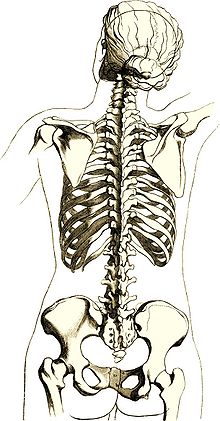Back Health Anatomy Fitness Guide
The back anatomy outline of a healthy spinal column, it's structure and how it works.
The back or spinal column is made of a series of bones called vertebrae. These vertebrae run from the base of the skull all the way down to the pelvis. Vertebrae have cushions between them called discs that absorb the shock and stress the body places upon them.
Three natural curves to the back give it the "S" shape. These curves provide more even distribution of body weight which allows the spine to withstand a tremendous amount of stress and maintain good health.
The spine is divided into four regions or sections and they are:
- cervical or neck area
- thoracic or chest and trunk area
- lumbar or low back area
- sacral or pelvic area

As we look at the first area in this anatomy guide, which is our neck, we can see the importance that body fitness would play in allowing our body to function properly.
Our neck has seven vertebrae and they are numbered from C1 to C7, starting at the top and going to the bottom. The purpose of the neck is to support and give movement and flexibility to the head.
At the top, the first two vertebrae are special to allow for head movement. The first vertebrae is called the atlas and has a ring-like shape or hole in it with two large protrusions at the sides to support the head. The second vertebrae called the axis has a bony projection called the odontoid on its upper surface. This projection fits into the ring shape of the atlas to provide movement for the head.
The neck has an inward curve that is called a lordotic curve.
The chest consists of twelve vertebrae that are numbered from T1 to T12. From these the ribs are attached and therefore they have less movement. This more rigid structure provides protection for the heart, lungs and other internal organs. The thoracic or chest has an outward curve or a kyphotic curve.
Our lumbar or low back is made of five lumber vertebrae numbered L1 to L5. This number of lumbar can vary, some people have six. These vertebrae are the largest because they carry most of the body's weight. Lumbar vertebrae curve naturally inward like a reverse "C" in a back anatomy that is in good health.
The pelvic or sacrum is located below the lumbar vertebrae and consists of several vertebrae that are fused together. At the end of the sacrum is the tailbone which is called the coccyx.
We will now take a look at the vertebrae it's self in our back health guide with a better understanding how health fitness affects the whole body anatomy.
A vertebrae is made of several parts that have three basic functions.
- The large drum shaped body is constructed to withstand weight and compression.
- The lamina, pedicles and facet joints form the arch on the backside of the vertebrae body.
- Also the transverse process to which the muscles are attached make up a part of this posterior arch.
Vertebrae are made of harder or cortical bone on the out- side and softer less dense bone on the inside.
The intervertebral disc is attached to the end plates, which are the top and bottom of the main body. These discs have a gel-like center and a tough outer layer that acts much a shock absorber.
The pedicle projects to the back as it comes out of the side of the vertebral body and protects the spinal cord as it makes up the side walls for the spinal canal.
Laminae are two plates of bone that come from the pedicles and join to form the spinous process, which you can feel by touching your back.
At the point where the vertebrae contact each other is called the facet joint. There are two sets of facet joints for each vertebra, one at each side at the top and the bottom.
The third vertebral function covered here in the back health guide consists of two transverse processes for each vertebrae body. These transverse processes project out from each side where the laminae and pedicles join together. From these projections are where the muscles and ligaments are attached to support and move the body.
Through this canal created by this structure, runs the spinal cord from which it branches out into thirty one spinal roots into nerves that control your body.
When we have a better understanding of our spinal column, we realize just how important health fitness is for our body to be able to function properly.